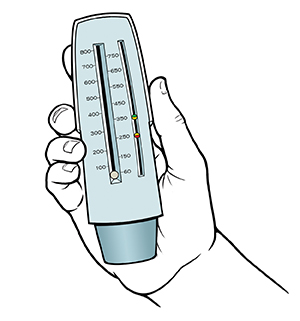Asthma: Using a Peak Flow Meter
What is a peak flow meter?
A peak flow meter is a device used to measure how well your asthma is under control.

The device measures air flow out of the lungs (peak expiratory flow rate or PEFR),
as you blow into it. When used correctly, a peak flow meter can show that you have
narrowing of the airways before you have symptoms. Peak flow readings can help you
know:
-
When to get emergency medical care
-
How well your asthma treatment plan is working
-
When to stop or add medicine, as directed by your healthcare provider
-
What triggers your asthma symptoms
What are peak flow zones?
Peak flow zones may be part of your Asthma Action Plan. If you don't have an Asthma
Action Plan, or if yours isn't up-to-date, make sure you talk with your healthcare
provider. The 3 zones tell you when your asthma is controlled, when it is getting
worse, and when it is severe. They are based on the traffic light concept. Green means
safe. Yellow means caution. Red means danger. Based on your personal best peak flow
measurement (your best lung function), your 3 peak zones include:
-
Green. This is 80% to 100% of your personal best peak flow measurement. This means your
asthma is under control.
-
Yellow. This is 50% to 79% of your personal best peak flow measurement. This is a sign that
your asthma is getting worse. You may need to use quick-relief medicines or other
medicine, as directed by your healthcare provider.
-
Red. This is below 50% of your personal best peak flow measurement. This is a medical emergency. You should take quick-relief medicine and get medical help right away.
Using peak flow zones helps you see when your asthma may start to become uncontrolled.
The goal is to stay in the green zone. Zones with a smaller range, such as 90% to
100%, may be recommended by some healthcare providers.
The numbers for each of your peak flow levels should be marked on your meter. If you
need help with this, ask your healthcare provider or nurse. Your provider will also
note your usual symptoms and what you should do for each zone in your Asthma Action
Plan. The steps could be such things as what medicine to take, when to call the healthcare
provider, or when to go to the emergency room.
How is a personal best peak flow measured?
Your peak flow zones are based on your personal best peak flow. To find your personal
best peak flow, take your peak flow measurement each day at the same time in the middle
of the day for 2 to 3 weeks, when your asthma is under control . Write down all of the readings. Your personal best is the highest number during
this time. This number is important if your asthma provider has given you an Asthma
Action Plan that uses your peak flow.
Your personal best peak flow measurement may change over time. Talk with your healthcare
provider about when you should recheck your personal best.
When should a peak flow meter be used?
Use your peak flow meter regularly to check how well your asthma is being controlled.
Measure your peak flow:
-
Each morning, before taking asthma medicines
-
When you have symptoms or an asthma flare-up
-
After taking medicine for an asthma flare-up
-
Other times as advised by your healthcare provider
Talk with your healthcare provider about when and how often you should be checking
your peak flow readings. Tell your provider your peak flow readings.
How do I use the peak flow meter?
-
Stand up or sit up straight
-
Place the marker at zero or the lowest number
-
Take a deep breath. Put the mouthpiece into your mouth and wrap your lips tightly
around it. Don't block the mouthpiece with your tongue. Make sure you don't have anything
in your mouth, like gum.
-
Blow out through the mouthpiece as hard and fast as you can in 1 breath
-
The breath should move the marker on the meter. Note the number.
-
Repeat this routine a total of 3times
-
Record the highest of the 3 readings
How can I get a peak flow meter?
Peak flow meters are available at most drugstores and pharmacies. Some healthcare
providers may also have them in their offices. Make sure you read all directions that
come with the meter. If you have any questions, ask your provider or nurse. The best
way to know if you are using the meter correctly is to use it in front of your healthcare
provider or a nurse.